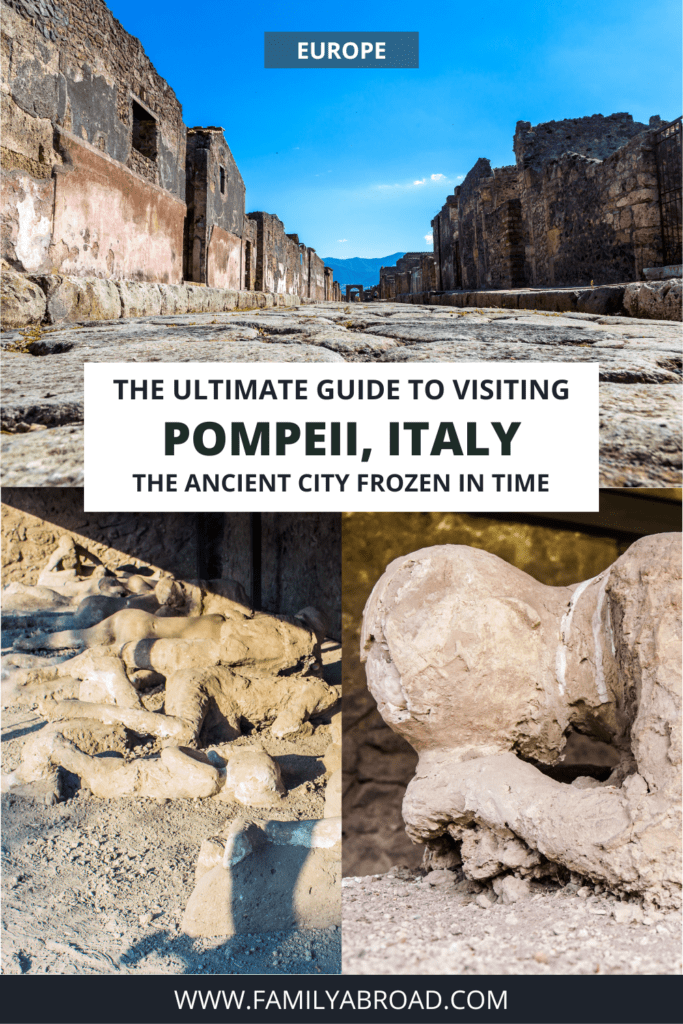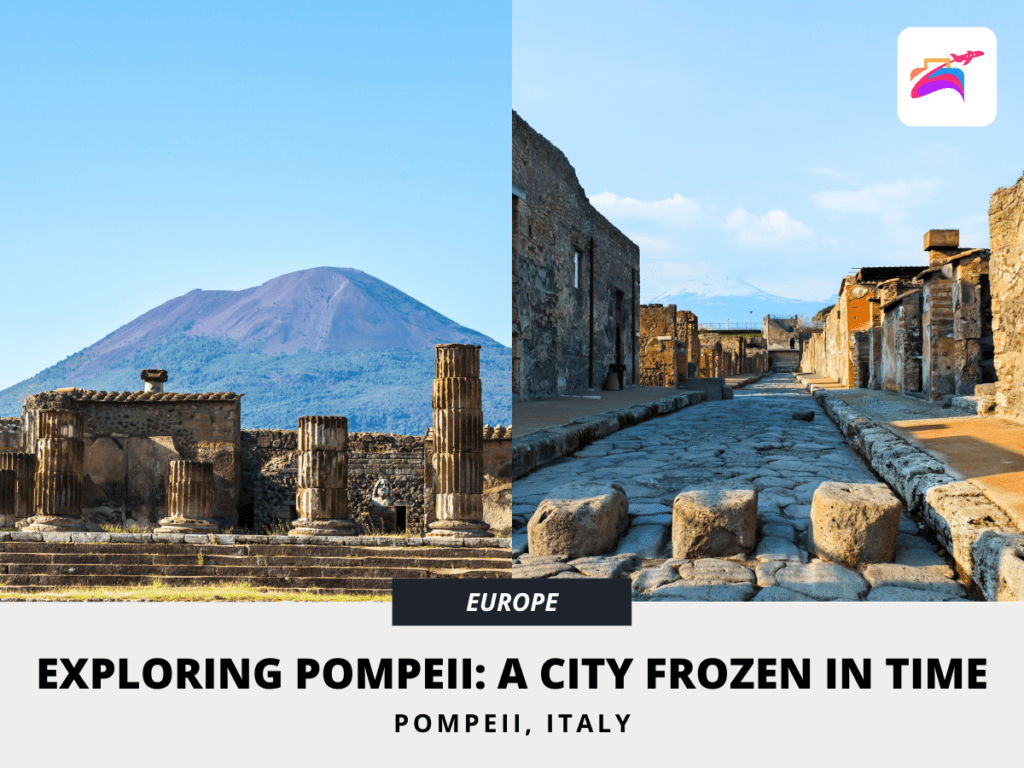SHORT HISTORY OF POMPEII
Pompeii, an ancient Roman city, was founded around the 7th century BC in the region known as Campania, in present-day Italy. Located near the Bay of Naples, Pompeii flourished as a bustling and prosperous trading center, thanks to its strategic position and fertile surroundings. However, in 79 AD, disaster struck when Mount Vesuvius, the nearby volcano, erupted violently, burying the city under layers of volcanic ash and debris.
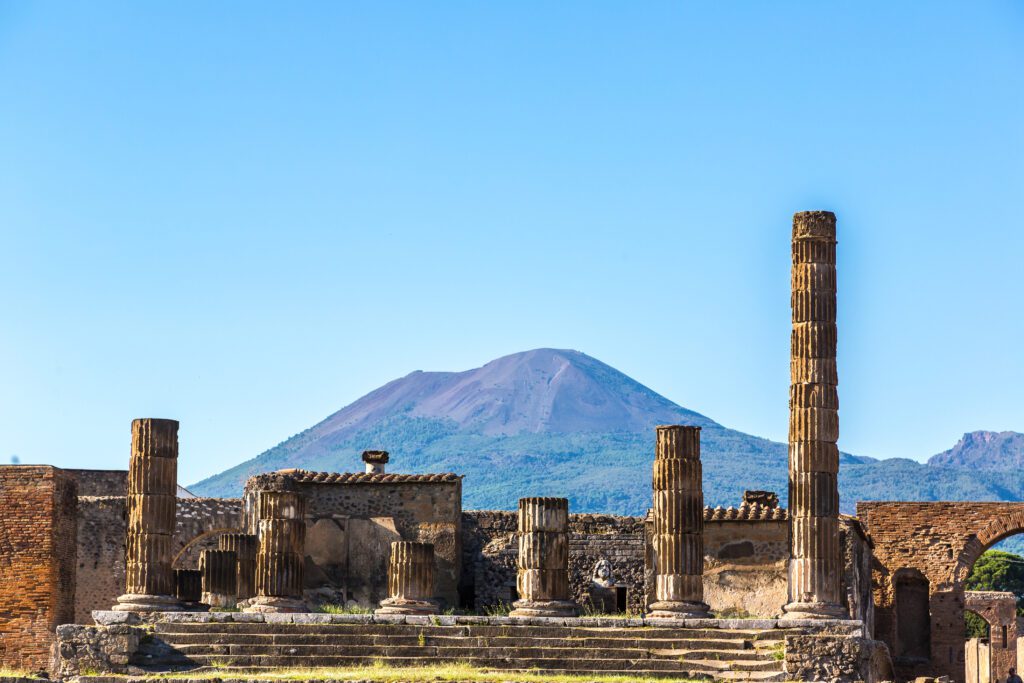
Pompeii, with the volcano, Mount Vesuvius, in the background
The eruption of Mount Vesuvius was catastrophic, completely decimating Pompeii and its neighboring cities. The sudden volcanic eruption caught the inhabitants off guard, trapping them in a state of suspended time. The ash and pumice that blanketed the city not only buried buildings and streets but also preserved them remarkably well, offering archaeologists and historians an unparalleled glimpse into daily life in ancient Rome.
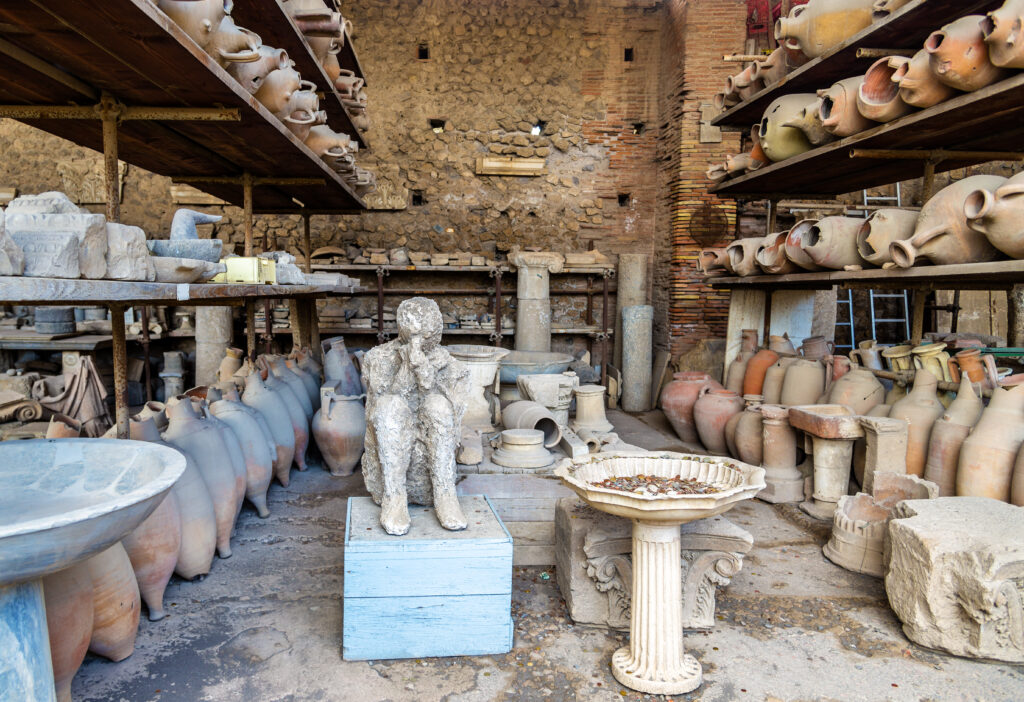 Remains of a victim and pottery excavations in Pompeii
Remains of a victim and pottery excavations in Pompeii
For centuries, Pompeii remained buried and forgotten until its rediscovery in the 18th century. Excavations began, and the remarkably preserved city started to unveil its secrets. Buildings, artifacts, and even the casts of human bodies encased in ash were unearthed, providing invaluable insights into Roman architecture, art, culture, and society.
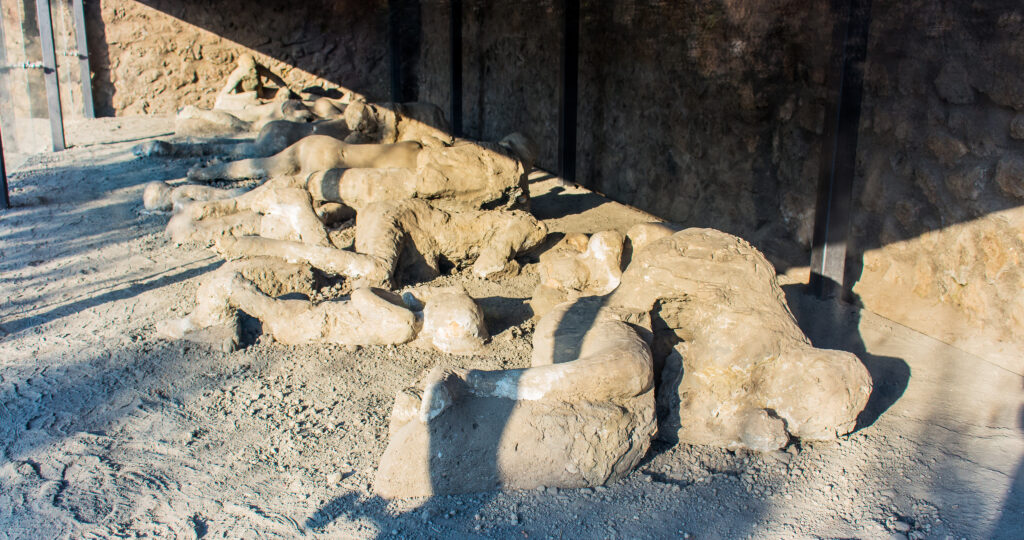 Plaster casts of Pompeii victims killed by the eruption of Mount Vesuvius
Plaster casts of Pompeii victims killed by the eruption of Mount Vesuvius
Today, Pompeii stands as a UNESCO World Heritage Site and a captivating archaeological marvel. It offers visitors a unique opportunity to wander through its streets, explore its houses, temples, and public buildings, and witness firsthand the well-preserved remnants of an ancient Roman city frozen in time. The story of Pompeii serves as a strong reminder of the fragility of human existence and the enduring power of nature, making it a must-visit destination for history enthusiasts and curious travelers alike.
ANCIENT LIFE IN POMPEII
Life in Pompeii was vibrant and diverse, reflecting the broader culture of the Roman Empire during the 1st century AD. Pompeii was a thriving city with a population of approximately 20,000 people, consisting of a mix of Roman citizens, freed slaves, and foreigners from various regions of the Mediterranean.
The society of Pompeii was hierarchical, with a clear distinction between social classes. Wealthy aristocrats and merchants lived in luxurious villas, adorned with beautiful frescoes, intricate mosaics, and lavish furnishings. They enjoyed a life of leisure, engaging in intellectual pursuits, attending public baths, and participating in elaborate social gatherings.
Commerce played a crucial role in Pompeii’s economy, as the city was a bustling hub of trade. The Forum, a central marketplace, was the heart of commercial and political activities. Shops and workshops lined the streets, selling a wide range of goods, including food, clothing, jewelry, and pottery.
Religion held a significant place in the lives of Pompeians, with various temples dedicated to Roman gods and goddesses dotting the city. Religious festivals and ceremonies were celebrated with great enthusiasm, and Pompeii had its own religious cults and practices alongside the state-sanctioned Roman religion.
Entertainment was also an integral part of daily life in Pompeii. The city boasted an amphitheater where gladiatorial games and other spectacles took place, providing thrilling entertainment for the masses. Theaters hosted plays, musical performances, and comedic shows, showcasing the artistic talents of the time.
Pompeii’s society was multilingual and multicultural. Latin was the official language, but Greek was also widely spoken. Being a cosmopolitan city, Pompeii attracted visitors and traders from different parts of the Mediterranean, contributing to a diverse and dynamic cultural environment.
WHERE IS POMPEII LOCATED?
Pompeii is located in the Campania region of southern Italy, near the city of Naples. It is situated in the province of Naples, specifically in the municipality of Pompei. The ancient city is nestled at the southeastern base of Mount Vesuvius, a volcano that played a significant role in its destruction and preservation. With its strategic location in Campania, Pompeii attracts visitors from around the world who are eager to explore its archaeological wonders and immerse themselves in its rich history.
HOW TO GET POMPEI
Getting to Pompeii is relatively easy, thanks to its convenient location. If you’re staying in Naples, you can reach Pompeii by taking a short train ride on the Circumvesuviana line to Pompeii Scavi-Villa dei Misteri station. The journey takes approximately 30 minutes, and once you arrive, the entrance to the archaeological site is just a short walk away. If you’re coming from other parts of Italy, there are also train connections available from major cities like Rome and Florence.
HOW MUCH DOES IT COST TO VISIT?
The cost of admission to Pompeii is quite reasonable, making it an accessible destination for families. As of our visit, the ticket price for adults was approximately €15, with discounted rates for children and seniors.
It’s worth noting that ticket prices may vary, so it’s best to check the official website or inquire at the ticket office for the most up-to-date information.
Take note: official tickets for Pompeii are only sold at the entrance, not at other places like the train station.
WHAT TIPS DO YOU NEED TO KNOW FOR YOUR VISIT?
To make the most of your visit, here are some valuable tips we learned along the way. First, wear comfortable shoes as you’ll be doing a lot of walking on uneven surfaces. The sun can be scorching, so don’t forget to bring sunscreen, hats, and plenty of water to stay hydrated. Exploring Pompeii can be a long and immersive experience, so packing some snacks or a picnic lunch is a great idea.
SHOULD I DO A GUIDE, AUDIO GUIDE, OR A DIY TOUR?
When it comes to touring options, you have a few choices.
If you prefer a more structured experience, hiring a local guide or opting for an audio guide can enhance your visit. These knowledgeable companions provide historical context and fascinating stories that bring the ruins to life.
However, if you enjoy the freedom to explore at your own pace, a self-guided tour is a fantastic option. There are plenty of informative signs and maps throughout the site to help you navigate and understand the significance of each area.
THE POMPEII MUSEUM
Pompeii finally has its very own museum. In the Pompeii Museum – Antiquarium, you can explore the captivating history and see the most significant artifacts on display.
Previously, visitors would have to visit the Archeological Museum – Mann in Naples to admire the excavations from Pompeii and Herculaneum. But now you can simply enter the Archaeological Park of Pompeii and immerse yourself in the 11 rooms of the new museum.
Opened in January 2021, the museum takes you on a journey through the history of Pompeii, from its founding in the 7th century BC to the catastrophic eruption in October 79 AD. Located under the terrace of the Temple of Venus, not far from the Forum, you’ll find the world-famous plaster casts of the victims of Pompeii on display.
If you’re visiting Pompeii, there is no need to purchase a separate ticket for the museum. We would recommend allotting at least 40 to 45 minutes to explore all the rooms.
The museum also offers informative panels and a free audio system in English. Just make sure your smartphone has a QR code reading app to access the audio guide.
OUR FAMILY VISIT TO POMPEII
Our family trip to this ancient archaeological site was was like stepping into a real-life history book. Pompeii, once a bustling Roman city, now stands as a remarkable testament to the power of nature and the resilience of its people.
 The McClure Family in Pompeii!
The McClure Family in Pompeii!
Our visit began at the museum, where we marveled at the preserved remains of humans and animals, including horses. The exhibits provided a detailed history of Pompeii, giving us a deeper understanding of the city’s rich past.
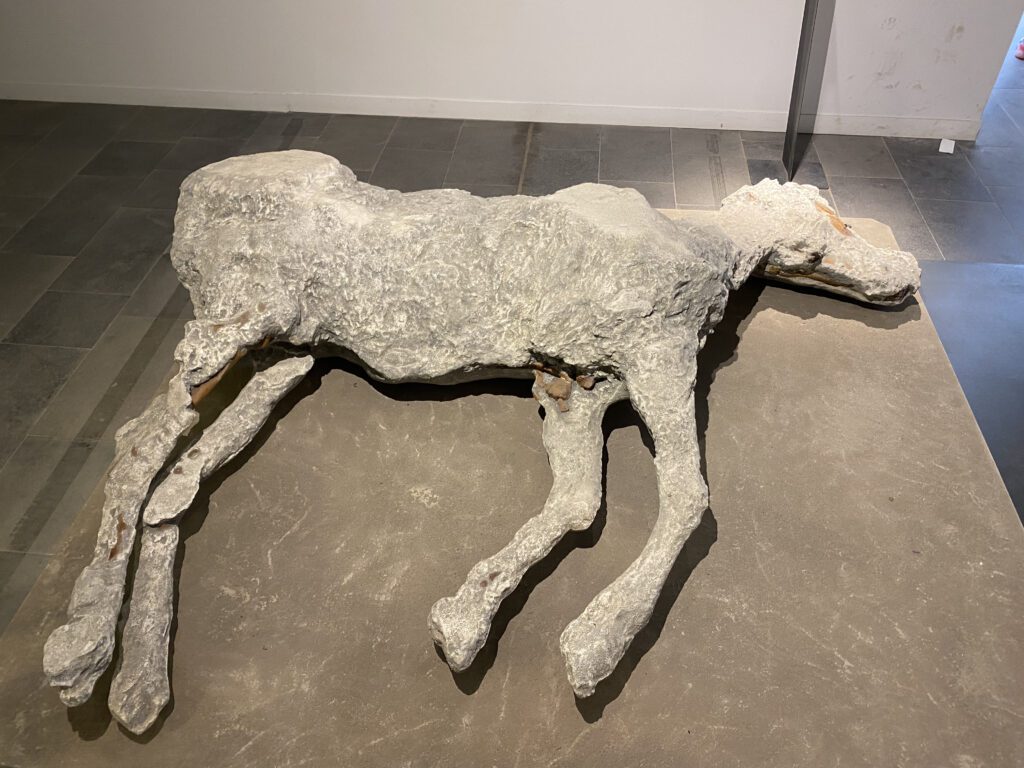 Preserved remains of a horse in the Pompeii Museum
Preserved remains of a horse in the Pompeii Museum
 Preserved remains of a human in the Pompeii Museum
Preserved remains of a human in the Pompeii Museum
To make the most of our visit, we decided to hire a local tour guide to accompany us and let us in on all the secrets of Pompeii. His expertise and storytelling brought the city back to life as he shared captivating tales and insights.
We learned about the catastrophic eruption that wiped out the entire city. It’s mind-blowing to think that this once-thriving metropolis was frozen in time by the volcanic ash, preserving it for centuries. Today, Pompeii is renowned for its exceptional preservation, giving us a unique glimpse into the daily lives of its inhabitants.
Our tour guide led us through the fascinating ruins, pointing out key sites such as the Forum and the winding streets.
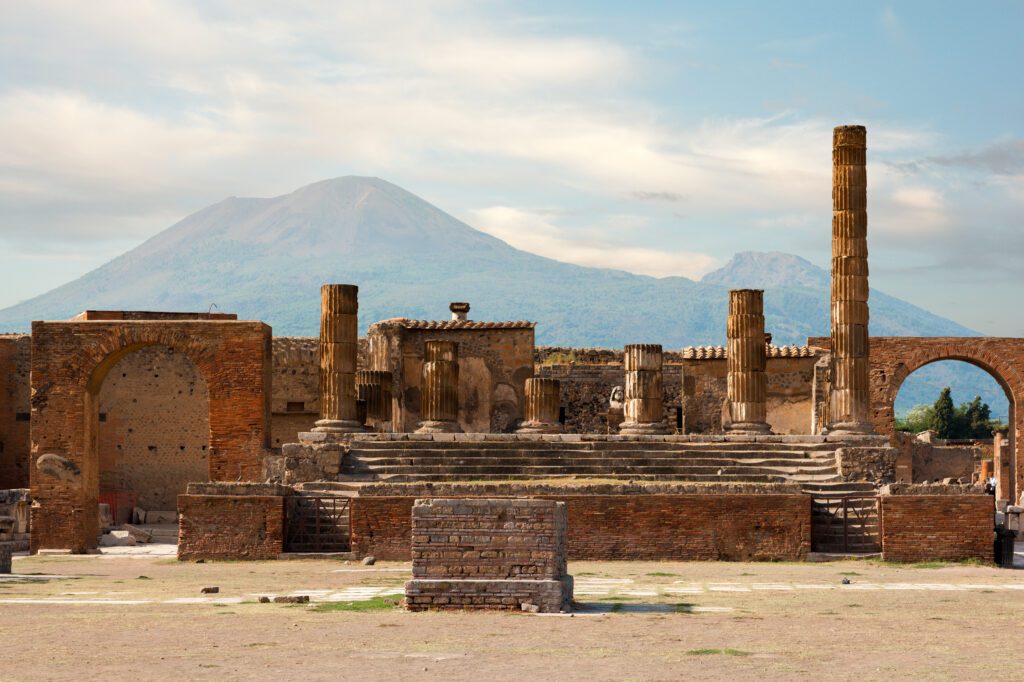 Ancient ruins of Pompeii with Mount Vesuvius in the background
Ancient ruins of Pompeii with Mount Vesuvius in the background
Forum of Pompeii was the bustling center of political, social, and economic activity in ancient times. It served as the heart of the city, hosting important public events, political debates, and commercial transactions. Today, visitors can explore the well-preserved ruins of the Forum, witnessing the remnants of its grand temples, markets, and civic buildings.
One thing we found hilarious was a surprising discovery our guide showed us. Because Pompeii didn’t have street names like we do now, they had this sneaky marker on the ground. It was an unmistakable phallic shape, to point to where the brothel was.
 Ruins of ancient roads and crosswalks in Pompeii
Ruins of ancient roads and crosswalks in Pompeii
Pompeii’s population was wildly diverse and very multicultural. They spoke all sorts of languages since people from different parts of the Mediterranean settled there. It must have been chaotic trying to communicate. For visitors who didn’t speak the local tongue, communication relied heavily on visual cues and gestures. Imagine trying to get your point across with just hand gestures and pointing. It’s a wonder they got anything done!
We also got to see the Pablinium, which was an important room within a Roman house that served as a reception area for guests. It was typically located near the entrance and featured decorative elements such as frescoes and ornate furnishings. The Pablinium provided a welcoming and impressive space where visitors could be received, showcasing the wealth and social status of the homeowner.
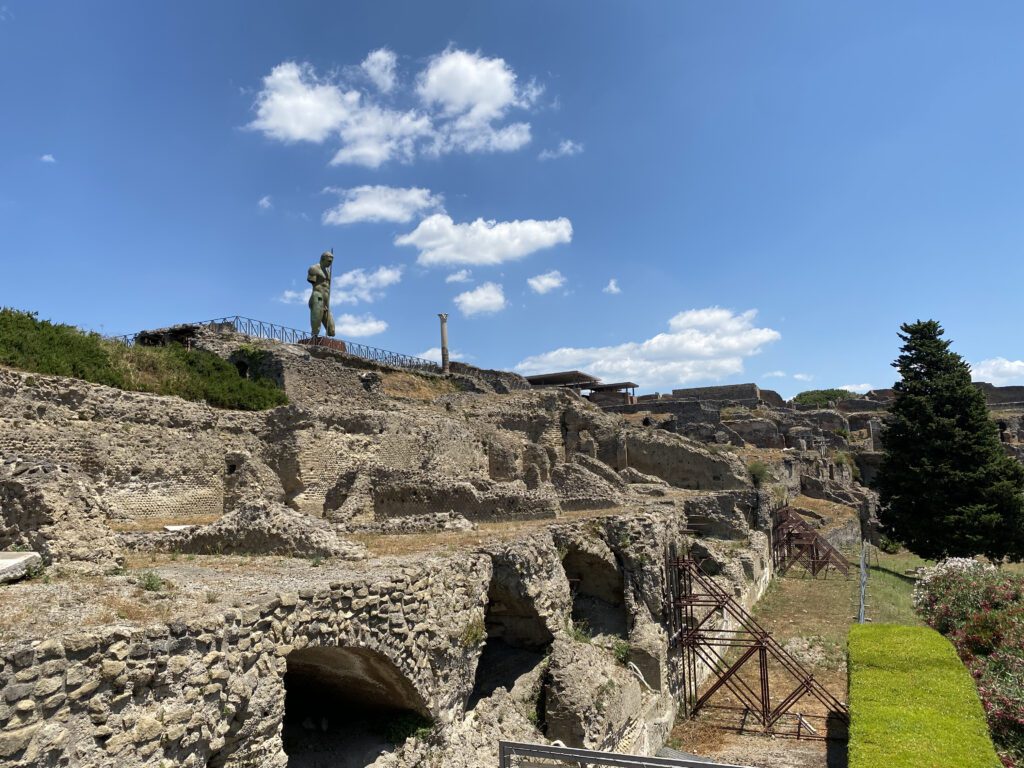 The ruins of the ancient city of Pompeii
The ruins of the ancient city of Pompeii
What sets Pompeii apart from other archaeological sites, such as Rome, is its unique state of preservation. The ash from Mount Vesuvius effectively encased the city, protecting it from decay and offering an unparalleled snapshot of ancient life. Walking through the streets of Pompeii feels like stepping into a time machine.
Our trip to Pompeii was seriously one for the books. We learned so much about the history of the place and the amazing people who called it home. It’s crazy to think how a tragic volcano eruption wiped it all out. We feel thankful that we got the opportunity to visit this this unique historical site. It’s definitely a fascinating story to tell and we mad a lot of good memories exploring the place.
WATCH THE FULL VIDEO HERE
Like this post? Pin it on Pinterest!
